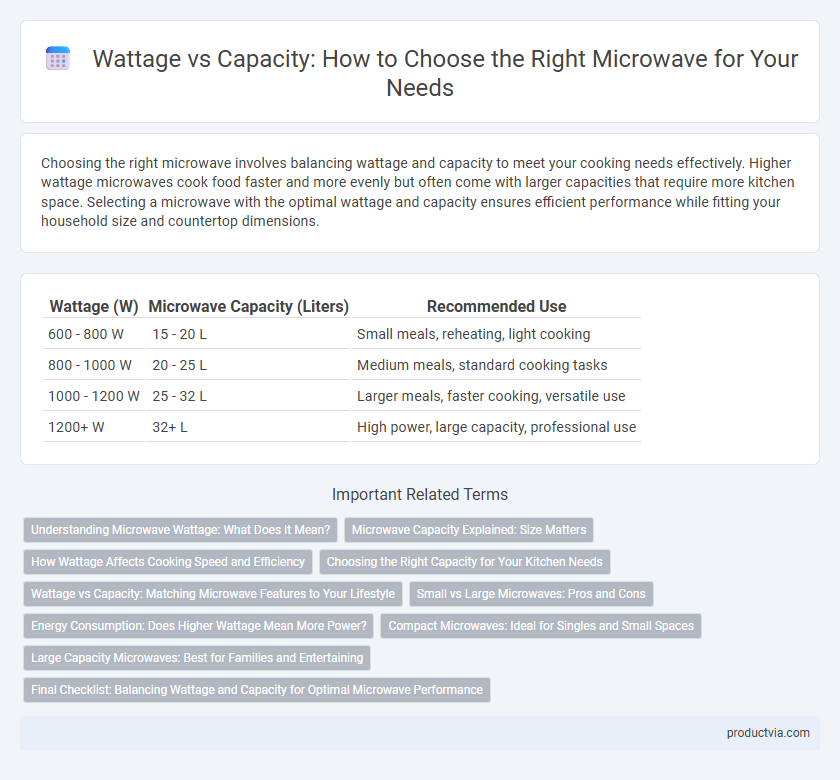Choosing the right microwave involves balancing wattage and capacity to meet your cooking needs effectively. Higher wattage microwaves cook food faster and more evenly but often come with larger capacities that require more kitchen space. Selecting a microwave with the optimal wattage and capacity ensures efficient performance while fitting your household size and countertop dimensions.
Table of Comparison
| Wattage (W) | Microwave Capacity (Liters) | Recommended Use |
|---|---|---|
| 600 - 800 W | 15 - 20 L | Small meals, reheating, light cooking |
| 800 - 1000 W | 20 - 25 L | Medium meals, standard cooking tasks |
| 1000 - 1200 W | 25 - 32 L | Larger meals, faster cooking, versatile use |
| 1200+ W | 32+ L | High power, large capacity, professional use |
Understanding Microwave Wattage: What Does It Mean?
Microwave wattage, typically ranging from 600 to 1200 watts, directly impacts cooking speed and efficiency, with higher wattage microwaves heating food faster and more evenly. Capacity, measured in cubic feet, determines the internal cooking space and influences the size of dishes that can fit, but does not affect cooking power. Selecting a microwave with adequate wattage ensures optimal performance, while appropriate capacity accommodates your kitchen needs and meal sizes.
Microwave Capacity Explained: Size Matters
Microwave capacity, measured in cubic feet, directly influences cooking efficiency and wattage requirements, as larger interiors typically demand higher wattage to ensure even heating and faster cooking times. Choosing the right microwave involves balancing size with wattage; a compact microwave around 0.7 cubic feet with 700-900 watts suits small portions, while larger models of 1.5 cubic feet or more often require 1000 watts or higher for optimal performance. Understanding this relationship helps consumers select microwaves that match their cooking needs without wasting power or space.
How Wattage Affects Cooking Speed and Efficiency
Higher wattage microwaves cook food faster and more evenly, improving overall cooking efficiency by delivering more energy per unit time. Microwaves with wattage between 800 to 1200 watts typically balance power consumption and cooking speed, making them ideal for everyday household use. Selecting a higher wattage microwave can reduce cooking times significantly, especially for larger capacity models that require more energy to heat food thoroughly.
Choosing the Right Capacity for Your Kitchen Needs
Selecting the right microwave wattage and capacity is essential for efficient cooking and space optimization. Higher wattage microwaves, typically ranging from 900 to 1200 watts, heat food faster, while capacity, measured in cubic feet, determines how much food can be cooked at once--compact models range from 0.5 to 0.8 cubic feet, ideal for small kitchens or reheating. For families or frequent cooking, choosing a capacity between 1.2 and 2.0 cubic feet ensures sufficient space for larger dishes, balancing power and size to meet specific kitchen needs.
Wattage vs Capacity: Matching Microwave Features to Your Lifestyle
Selecting a microwave with the right wattage and capacity is crucial for matching your cooking habits and kitchen space. Higher wattage microwaves, typically ranging from 900 to 1200 watts, offer faster cooking times and better performance for larger capacity interiors, usually measured in cubic feet from 0.7 to 2.2 cu. ft. Balancing wattage and capacity ensures efficient meal preparation, whether reheating small meals or cooking family-sized dishes.
Small vs Large Microwaves: Pros and Cons
Small microwaves typically have wattages between 600 and 900 watts, offering lower cooking power ideal for reheating or small portions, while large microwaves range from 1000 to 1500 watts, providing higher capacity and faster cooking times suitable for family meals. Higher wattage in large microwaves ensures uniform heating and efficient defrosting, but this comes with increased size and energy consumption, which may not be ideal for limited kitchen spaces. Small microwaves benefit from compact designs and energy efficiency but may struggle with evenly cooking larger dishes or multiple servings.
Energy Consumption: Does Higher Wattage Mean More Power?
Microwave wattage directly affects cooking power and time, with higher wattage typically leading to faster food heating but not necessarily higher energy consumption overall. Energy efficiency depends on matching wattage to capacity; a large microwave with low wattage may run longer, using more energy than a smaller, higher-wattage model that cooks quickly. Selecting a microwave requires balancing wattage and capacity to optimize energy use while ensuring adequate cooking power for your needs.
Compact Microwaves: Ideal for Singles and Small Spaces
Compact microwaves with wattage typically ranging from 600 to 900 watts efficiently balance power and size, making them ideal for singles and small spaces. Their smaller capacity, usually between 0.5 to 0.8 cubic feet, optimizes countertop space without sacrificing essential cooking performance. Choosing a compact microwave with appropriate wattage ensures quick heating and energy efficiency tailored to limited kitchen areas.
Large Capacity Microwaves: Best for Families and Entertaining
Large capacity microwaves with higher wattage, typically above 1000 watts, ensure faster and more even cooking for family-sized meals and entertaining guests. A spacious interior, around 1.5 to 2.0 cubic feet, accommodates bigger dishes and multiple containers simultaneously, improving convenience during gatherings. Prioritizing both wattage and capacity optimizes microwave performance, making it ideal for households requiring efficient meal preparation on a larger scale.
Final Checklist: Balancing Wattage and Capacity for Optimal Microwave Performance
Selecting the ideal microwave involves balancing wattage and capacity to match your cooking needs efficiently. Higher wattage ensures faster cooking times and even heating, while appropriate capacity accommodates the size of your dishes and kitchen space. Prioritize microwaves with wattage between 700 to 1200 watts and a capacity ranging from 0.7 to 2.0 cubic feet for versatile and optimal performance.
Wattage vs Capacity for microwave selection Infographic

 productvia.com
productvia.com